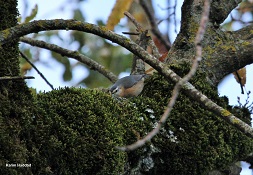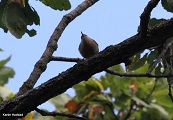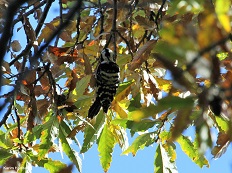Photos with this report (click to enlarge) | |||
 Algerian Nutahtch |
 Algerian Nuthatch |
 Lesser spotted woodpecker |
|
Since we knew about the existence of the mythical “Algerian Nuthatch” in late 80’s (when it was still possible to visit Algeria although we were too young to make it), we had dreamed about being able to reach the forests around Mount Babor and watch this very much sought after bird.
Not only the civil war during the 90’s, but also because of possible terrorist groups hidden in the mountains (as “maquis” did during 90’s), it was a risk trying to visit this country. It was not until a few years ago when some European and American birdwatchers managed to enter the region, lately through Karim Haddad, a very nice local naturalist from Constantine.
We contacted him (karim241267@yahoo.fr) and (Tel., Watsapp, Viber +213 657 016 272) and he soon answered us explaining all sort of details, and telling us about the absolute safe conditions currently in this region. He is a person to trust on, and he can arrange all the logistical details for you with all included and he even offered us some dates as a present.
To enter the country it’s necessary to get a visa (60€ in Spain, through Barcelona consulate), which takes around 15 days.
Algeria is surprisingly close to Catalonia, just 513 km straight south from Barcelona (exactly the same distance as Madrid). We took a 45 minute Vueling flight from Barcelona to Algiers on Saturday morning (5:40h) and another 45 minute Air Algérie flight from Algiers to Constantine on Saturday morning (9:30h). On the way back, Constantine-Algiers was on Sunday at 19:30h and Algiers-Barcelona was at 22:45h, so we could manage to do a full weekend without even having to take a day off. Karim told us that in summer there are direct flights to Constantine from Barcelona.
The police was everywhere in the city and airports, but not once we were in the mountains and forests. During the passport control, they checked our luggage and, in spite of some camera and lenses questions, we were allowed to enter them in the country. However, we had not taken binoculars, as they are forbidden in the country as they are considered military gear. Karim provided a couple of decent ones for us, in order to look for the Nuthatch and other birds.
We slept in Hotel Ibis, in Constantine city center. Karim picked us up at the airport and dropped us there. We visited the city on Saturday afternoon. Next morning we met with Karim at 4 am and we left to the forests. We were back at the airport on Sunday afternoon, after a quick visit (and tea) at his house.
The language we used during the trip it was French. We can understand and talk it. However, Karim speaks good English, apart from Arab, French, Russian and Ukrainian (he has lived in Ukraine for 25 years).
The food was excellent, and both the first day by ourselves visiting the city, and the second day with Karim birding around, we went to local restaurants, which were cheap with nice typical Algerian food.
We felt absolutely safe during the whole trip. The first afternoon we visited by ourselves the incredibly spectacular city of Constantine. It’s got impressive canyons, dramatic bridges, houses over ridges and cliffs, natural bridges, and amazing small markets in narrow streets.
We easily saw the local Jackdaw subspecies cirtensis, found only within the city of Constantine (apparently its only other population in Tunisia is extinct) apart from Kestrels, Peregrine, Ravens, Crag Martins, etc. We loved to be just by ourselves, with the nice feeling that we were positively the only “tourists” in the city, which made the trip really intense and genuine. People were very friendly, and it was very interesting to talk to them (knowing French made it easier).
It felt so safe that Marc even went for a walk by himself during the night (Aleix and Ponç went to bed, as they had slept very few the night before).
On Sunday, we got up at 3:30h and met Karim at 4 am. We drove for around 3 hours to the North West (with a quick breakfast stop), close to Djimla where we left the car and made, easy, and nice hike during 4 hours around the oak -Quercus afares and Quercus canariensis - forest for 7 km.
We soon found all the target birds which turned to be easy on early morning: Levaillant’s Woodpecker, African Blue Tit, and the endemic subspecies Maghreb Coal Tit (Parus ater ledouci), Black-crowned Jay (Garrulus glandarius cervicalis) and Lesser Woodpecker (Dryobates minor ledouci), found only in NE Algeria and Tunisia. Although we soon heard the rasping call of the Algerian Nuthatch (very different that the Eurasian one) it was not so easy to see it. It took us around 2 hours to have decent views. We finally managed to see around 8-9 birds during the 4 hour hike around the area, and we could take several pictures, call records and videos of both male and female. Our dream got true and we were really happy about the experience.
During 2018, the University of Bejaia made a census which turned to set around 61 individuals as the whole population in this area, which is supposed to be protected but in high risk of being cut, overgrazed and damaged by local farmers, timbers and even by the Algerian Government (a recreational area is being proposed to be set on it). The truth is that even it looks pretty big, it’s not that much and, most worrying, there are no young trees, as it has been intensively grazed for years.
Karim estimates that the global world population is around 1000 individuals (400 hundred pairs + 200 lonely individuals), most of them in Mount Babor (which is difficult to reach and still a bit dangerous, as he told us), Djimla forests and 3 other small oak forests facing north in several mountains and slopes in the area. But it’s necessary a serious and professional work must be organized, which must be financed by international organizations in order to have the real number of the population in all forests, informed us Karim.
However, he is actively looking for more areas and he presumes he’ll be able to find new small-localized populations in some north-facing forests of the surrounding valleys.
Karim also runs a local NGO (AquaCirta Environmental Association) trying to work for the forests and conservation, so if you decide to visit the country in order to see the Algerian Nuthatch is a good idea to do it with him, as the money you “leave” in the country through Karim, will be also used for him to try to work with environmental purposes.
Note
If you need more information about Nuthatch’s trip in North Algeria or you would like to visit South Algeria to see African silver bill or Red-billed firefinch, do not hesitate to contact us in anytime, we can help you to see any bird in any region at any time in Algeria.
Karim Haddad Ornithological tour leader Field Guide/Environmental Association AquaCirta
Cité Boussouf
Constantine 25000, Algeria email: karim241267@yahoo.fr
Cell. Ph., Watsapp, Viber : +213 657 016 272 https://ebird.org/profile/Nzk1MTEx/world
Mallard (Anas platyrrhynchos)
Common Pochard (Ayhya ferina)
Crested Grebe (Podiceps cristatus)
Cormorant (Phalacrocorax carbo)
Cattle Egret (Bubulcus ibis)
Grey Heron (Ardea cinerea)
Osprey (Pandion haliaetus)
Long-legged Buzzard (Buteo rufinus)
Peregrine (Falco peregrinus)
Kestrel (Falco tinnunculus)
Yellow-legged Gull (Larus michachellis)
Black-headed Gull (Croicocephalus ridibundus)
Eurasian Coot (Fulica atra)
Rock Pigeon (Columba livia)
Wood Pigeon (Columba palumbus)
Collared Dove (Streptopelia decaocto)
Levaillant’s Woodpecker (Picus levaillanti)
Great Spotted Woodpecker (Dryobates major)
Lesser Spotted Woodpecker (Dryobates minor)
Crag Martin (Ptyonoprogne rupestris)
Meadow Pipit (Anthus pratensis)
White Wagtail (Motacilla alba)
Wren (Troglodytes troglodytes)
Black Redstart (Phoenicurus ochruros)
Stonechat (Saxicola rubicola)
Blackbird (Turdus merula)
Mistle Thrush (Turdus viscivorus)
Maghreb Coal Tit (Parus ater ledouci)
African Blue Tit (Cyanistes teneriffae)
Great Tit (Parus major)
Algerian Nuthatch (Sitta ledanti)
Short-toed Treecreeper (Certhia brachdactyla)
Black-crowned Jay (Garrulus glandarius cervicalis)
Sardinian Warbler (Sylvia melanocephala)
Spectacled Warbler (Sylvia conspicillata)
Chiffchaff (Phylloscopus collybita)
Common Sparrow (Passer domesticus)
Jackdaw (Corvus monedula cirtensis)
Raven (Corvus corax)
Spotless Starling (Sturnus vulgaris)
Common Chaffinch (Fringila coelebs africana)
Greenfinch (Carduelis chloris)
Goldfinch (Carduelis carduelis)
Serin (Serinus serinus)